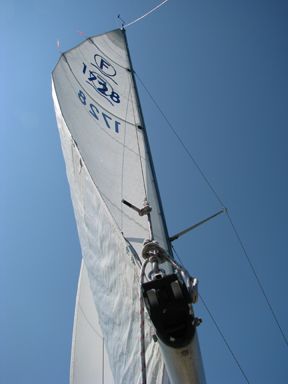The article on selecting a cruising mainsail coming up this month (August 2011) offers plenty of advice on choosing a main, but nothing on the important topic of sail trim. Unless you race as well as cruise-and our recent sail survey shows more than one-third of our readers do-you probably take a fairly casual approach to sail trim.

While you don’t have to be an incurable sail-tweaker to cover ground on a tradewind passage, assuring your mainsail is well-trimmed will put you safely at anchor sooner and ensure a smoother, more comfortable ride. Good mainsail trim, of course, is paramount when going to windward.
One of the best books on sail selection and trim that Ive found is Brian Hancocks “Maximum Sail Power.” I bought mine on Amazon for $14, but you can buy it used for less. Here are a few tips Hancock, a renowned ocean racer who is now a popular motivational writer and speaker, offers on the fundamentals of mainsail trim. If you are interested in getting the best performance out of your sails, Hancocks book is a good investment.
Telltales: No, you don’t need them, but why go without? Dont let pride get in the way of these extremely handy devices for checking sail trim. On the mainsail, you can attach them along the leach at the end of each batten. You can also attach them at the luff like you do with your jib, but because of airflow disturbance around the mast, these wont be as effective as they are on the headsail. You can buy stick-on, nylon telltales about a quarter-inch wide and attach them with some sticky-back Dacron. These are easier to see than basic wool yarn, particularly with a flashlight at night. (If you really want to get fancy for night sailing, the Glow Fast telltale patches look interesting for headsails.)
I use simple wool telltales stitched through the sail, with a couple of overhand knots to keep them from pulling through. Red seems the easiest for me to see. The downside to wool is that they are invisible at night and have to be replaced frequently as they fray. The upside is they are cheap and easy to replace. I also attach wool telltales to the shrouds. Sure, a windex and a digital wind indicator are more sophisticated wind-tracking tools, but, particularly in light breezes, tell tales are more helpful. The skin and hair on the back of your neck are also effective wind indicators, which is why I shun collars and hoods when running downwind in the tropics, particularly in squally weather.
Mainsail trim: As you settle into your desired heading, sheet in the main and watch the top telltale. When the top telltale dips behind the mainsail, followed by the others, ease the sheet until all the telltales are streaming again. Another basic way to check correct trim in light to moderate winds is that the top batten is parallel with the boom. However in very light winds, you will have to open the leach to maintain sail power. This gives the light air a clean path to exit the sail. Over-trimming in light air is a common mistake, even among experienced sailors.
Mainsail traveler: While the mainsheet changes the shape of the sail relative to the wind, the mainsail traveler is the more potent tool for adjusting the angle of attack when the boom is close to the centerline. The mainsail track is particularly helpful in heavier air when the boat is being overpowered. By using only the traveller to find ideal mainsail trim, you can effectively balance the boat by reducing or increasing weather helm. Finding that happy medium of weather helm makes the helmsman’s life easier, and it is easier on the autopilot or windvane.
Vangs: The vangs usefulness comes into play off the wind, when it keeps the leach from opening up and depowering the boat. Apart from sail trim, a modern hydraulic or mechanical vang supports the boom. In this sense it is doing the job of a topping lift, making reefing easier. Hancock makes an important point about vangs that is often overlooked: They should be easy to release. It is surprising how common it is to see a boat sail into port with a broken, or fractured boom that snapped or cracked when the boom dipped in the water, putting tremendous force at the point where the vang attaches to it.
These are fairly fundamental tips. Hancock, of course, goes into much more detail on these and other more advanced sail trim topics. Even if you don’t plan to race, and are in no hurry to get anywhere, the book is a helpful guide for anyone considering a new sail purchase.

































